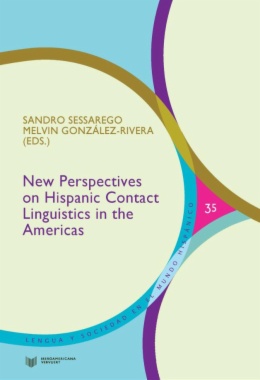This volume is an edited collection of articles dealing with Hispanic contact linguistics in the Americas. The project is composed of four main sections, organized according to the type of socio-historical scenario that characterizes the nature of the contact situation: Spanish in contact with indigenous languages; Spanish in contact with coerced-migration languages; Spanish in contact with free-migration languages; and Spanish in contact with languages outside of Latin America, but still within the Americas.
- Cover
- Title page
- Copyright page
- Table of contents
- Acknowledgments
- Introduction, Sandro Sessarego and Melvin González-Rivera
- Section 1. Spanish in contact with Indigenous languages
- Maya-Spanish Contact in Yucatan, Mexico: Context and Sociolinguistic Implications, Jim Michnowicz
- Rapanui Features in the Morphosyntactic System of Easter Island Spanish, Verónica González López
- The Formal Guaraní and Spanish of Paraguayan Bilinguals, Shaw Nicholas Gynan, Ernesto Luís López Almada, Carlos Marino Lugo Bracho and María Eva Mansfeld de Agüero
- Continuity and Innovation in Peruvian Spanish: Pragmatics and Contact in (Differential) Object Marking, Elisabeth Mayer and Manuel Delicado Cantero
- Borrowed Clause Combining Patterns in Two Arawakan Languages - Baure and Paunaka, Swintha Danielsen and Lena Terhart
- Section 2. Spanish in contact with coerced-migration languages
- Codeswitching and Borrowing in Aruban Papiamentu: The Blurring of Categories, Yolanda Rivera and Patrick-André Mather
- Nominal Ellipses in an Afro-Hispanic Language of Ecuador: The Choteño Case, Sandro Sessarego and Javier Gutiérrez-Rexach
- Cimarroneras in Venezuela: The Role of Isolated Communities in the Potential Development of a Spanish Creole, Avizia Yim Long and Manuel Díaz-Campos
- The Individual as the Locus of Variation and Change in a Contact Situation in Panama, Delano S. Lamy
- Section 3. Spanish in contact with free-migration languages
- Romance Language Contact in Mexico: The Case of Veneto-Spanish Bilingualism, Hilary Barnes
- Portuguese/Portuñol in Misiones, Argentina: Another “Fronterizo”?, John M. Lipski
- Preposition Stranding in a Non-Preposition Stranding Language: Contact or Language Change?, Melvin González-Rivera, Ramón Padilla-Reyes, and John Rueda-Chaves
- Definite and Indefinite Articles in Nikkei Spanish, Ana María Díaz-Collazos
- Section 4. Latin American Spanish outside of Latin America
- Doing Being Boricua on the Island and in the U.S. Midwest: Perceptions of National Identity and Lateralization of /ɾ/ in Puerto Rican Spanish, Wilfredo Valentín-Márquez
- Castilian in New York City: What Can We Learn from the Future?, Rafael Orozco
- Language Attitudes and Linguistic Identities in Miami, Diego Pascual y Cabo
- Heritage Speakers’ Spanish in California: How Unbalanced Bilingualism Affects Reverse Construction of the gustar-type, Viola Miglio and Stefan Th. Gries
- Spanish and English in Contact in the Cyber World, Antonio Medina-Rivera
- Contributors

